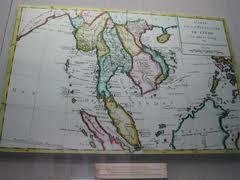Exhibition on Vietnam’s Maritime Cultural Heritage
Vinh Phong -
(VOVworld) – An exhibition entitled “Vietnam’s Maritime Cultural Heritage” took place at the National Museum of Vietnamese History in Hanoi at the end of May. On display were 300 exhibits as evidences of Vietnam’s significant contribution to the development of the international marinetime trading system and its sovereignty over its waters and islands. Vĩnh Phong reports…
The East Sea plays a pivotal role as it is at the intersection of international cultures and commerce between countries and continents worldwide. The exhibition is divided into different categories, ranging from prehistoric times to the 1000 BC, from the 1000 BC to the 18th century and from the 19th century to the modern age. Nguyễn Văn Cường, the director of the National Museum of Vietnamese History, told VOV: "With this exhibition, we want to express our love for our motherland and the sea, and to assert Vietnam’s sovereignty over its waters and islands. The exhibition is to mark President Ho Chi Minh’s birthday which coincides with the International Museum Day on May 18th, as well as to remind the public of these important issues."
This is also a historical account of Vietnam's long-standing and continuous sovereignty in the East Sea. Archaeological discoveries in Vietnam's coastal region's in prehistoric times show that the inhabitants of these areas not only had close and enduring ties with one another, but also traded and interacted with regions further afield. This included people in southern mainland China and the Phillipines. The exhibition also features photographs of cities and bustling ports across Vietnam and their contributions to maritime trading. Director of Quang Ninh Museum Trần Trọng Hà said his museum contributed 47 precious exhibits to the exhibition to help visitors learn more of the important role Vietnam’s ports and products played in the international navigation. Ha elaborated: "47 of the items on display indicate contact between Quang Ninh province and China, and Quang Ninh and Hoi An in 1000 BC. It also contains a collection of ceramics dating back from the 12th to the 17th centuries with many artifacts discovered in Quang Ninh and in Ostar, which today is better known as Egypt’s capital Cairo. This proves that from Van Don port in Quang Ninh province, Vietnamese pottery was transported and traded all over the known world."
 |
Copies of historical records and photographs from the 19th century underline Vietnam’s sovereignty over the Hoang Sa and Truong Sa archipenlagoes. More proof lies in the Dai Nam Map of the Minh Mang reign (1838), the Map of the Great An Nam Empire by father Jean Louis Taberd, and Nguyen Dynasty official documents (1939). Nguyễn Văn Huân from Ha Tinh province said the exhibition highlights the Vietnamese people’s love of the sea and its islands. Huan said: "The exhibition is an extensive collection of Vietnamese heritage found in our national islands and waters. It reminds us of the national tradition of defending our seas and islands from generation to generation, which should be continued."
Vinh Phong